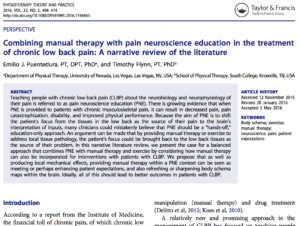by Mitch Hauschildt, MA, ATC, CSCS
I recently came across an article that I think is important that all clinicians read and understand. It is a simple read and not very long, so take a few minutes and read it here. The article looks at clinical outcomes for patients who present with chronic low back pain and have an approach of using manual therapy and/or using pain neuroscience education (PNE). I hope you will read the details in the article, but here are a few take homes for me:
- Pain is a highly individualized, complex and unique experience that clinicians must understand and appreciate. There is little research to link tissue damage with pain. They are separate experiences and constructs.
- Manual therapy performed under anesthetic did not improve outcomes, demonstrating a strong neurological component to manual therapy.
- Patients with low back pain expect that their low back will be touched at least to some extent as part of their therapy. If education is the sole means of their treatment, their clinical outcomes suffer because the clinician won’t meet the patient’s expectations.
- The body is mapped by the brain and when the map is disrupted, movement suffers and pain often follows. Manual therapy can redefine maps.
- “Expert” therapists had a patient-centered approach to care – collaborative clinical reasoning and patient empowerment.
The conclusions of the article strongly suggest that the combination of PNE with manual therapy offers the best outcome for people with chronic low back pain. This approach can and should apply to all areas of the body.


Leave a Reply